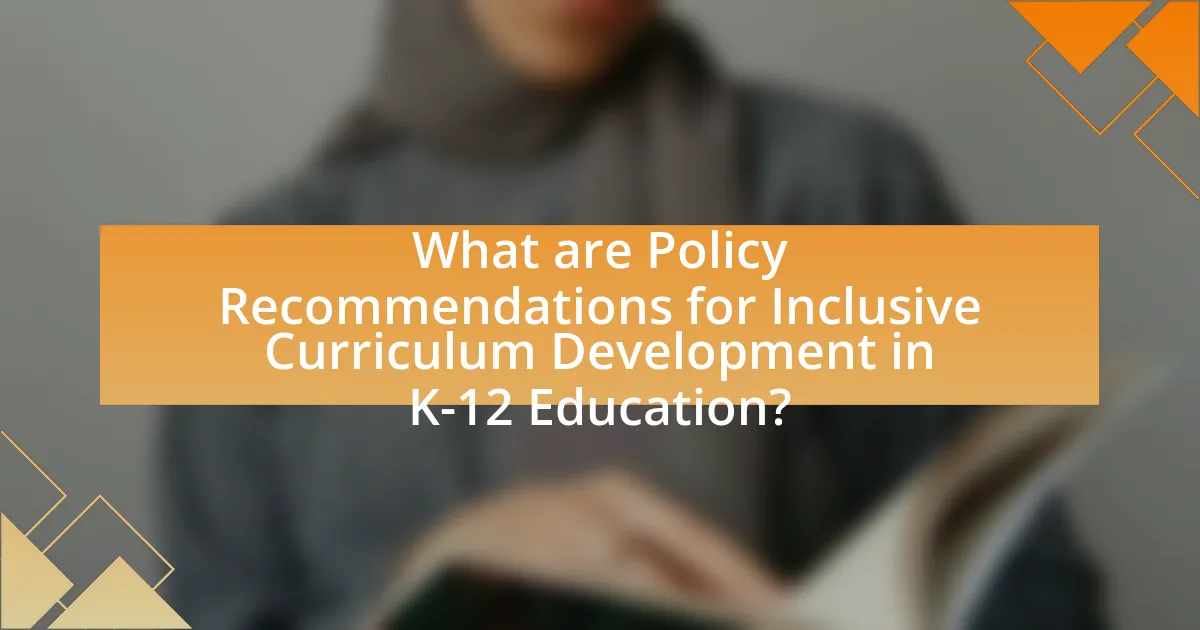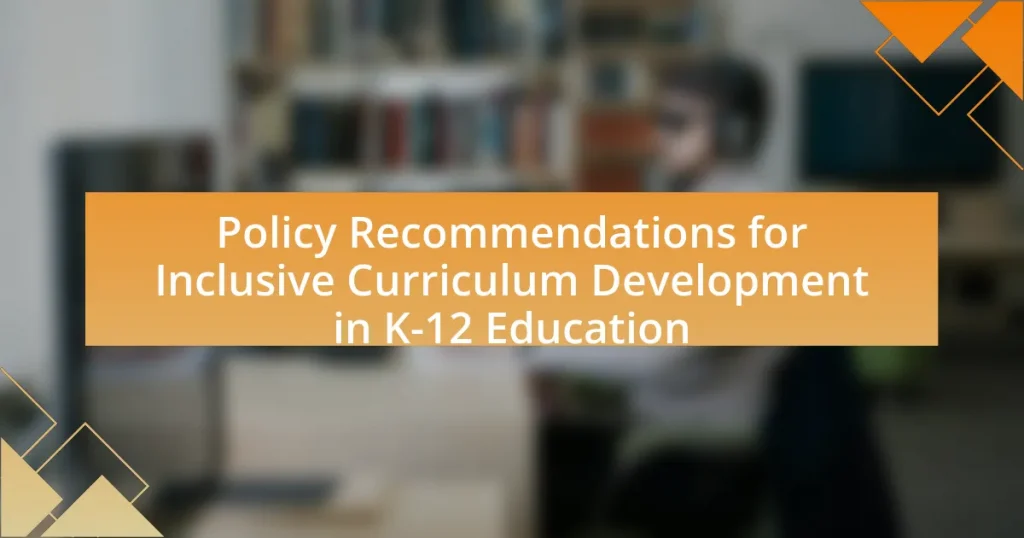The article focuses on policy recommendations for inclusive curriculum development in K-12 education, emphasizing the integration of diverse perspectives, accessibility, and culturally relevant pedagogy. It outlines the importance of inclusive curriculum in ensuring equitable learning opportunities for all students, highlighting key principles such as accessibility, equity, and participation. The article also addresses challenges faced in developing inclusive curricula, including resistance to change and lack of resources, while proposing strategies like collaborative planning and ongoing assessment to enhance inclusivity. Additionally, it discusses the role of policy frameworks and community engagement in supporting inclusive practices, ultimately aiming to improve educational outcomes for diverse student populations.

What are Policy Recommendations for Inclusive Curriculum Development in K-12 Education?
Policy recommendations for inclusive curriculum development in K-12 education include integrating diverse perspectives, ensuring accessibility, and promoting culturally relevant pedagogy. Integrating diverse perspectives involves incorporating materials and content that reflect the backgrounds and experiences of all students, which fosters a sense of belonging and engagement. Ensuring accessibility means designing curricula that accommodate various learning styles and needs, including those of students with disabilities, thereby complying with the Individuals with Disabilities Education Act (IDEA). Promoting culturally relevant pedagogy encourages educators to connect learning to students’ cultural contexts, enhancing relevance and motivation. Research indicates that inclusive curricula improve academic outcomes and social-emotional development, as evidenced by studies showing increased student engagement and achievement in diverse classrooms.
Why is Inclusive Curriculum Development important in K-12 Education?
Inclusive curriculum development is important in K-12 education because it ensures that all students, regardless of their backgrounds or abilities, have equitable access to learning opportunities. This approach fosters a sense of belonging and engagement among diverse student populations, which is essential for their academic success. Research indicates that inclusive curricula can improve educational outcomes; for instance, a study by the National Center for Learning Disabilities found that students in inclusive settings demonstrate higher academic performance and social skills compared to those in segregated environments. By addressing the varied needs of students, inclusive curriculum development promotes a more just and effective educational system.
What are the key principles of inclusive education?
The key principles of inclusive education are accessibility, equity, and participation. Accessibility ensures that all students, regardless of their abilities or backgrounds, have the necessary resources and support to engage in the learning process. Equity involves providing tailored educational opportunities that meet the diverse needs of each student, ensuring that everyone has a fair chance to succeed. Participation emphasizes the importance of involving all students in classroom activities and decision-making processes, fostering a sense of belonging and community. These principles are supported by research indicating that inclusive education leads to improved academic and social outcomes for all students, as highlighted in the UNESCO report on inclusive education practices.
How does inclusive curriculum impact student learning outcomes?
An inclusive curriculum positively impacts student learning outcomes by fostering a sense of belonging and engagement among diverse learners. Research indicates that when students see their identities and experiences reflected in the curriculum, they are more likely to participate actively and perform better academically. For instance, a study published in the “Journal of Educational Psychology” found that inclusive teaching practices led to a 20% increase in student achievement scores among marginalized groups. This demonstrates that inclusive curricula not only enhance academic performance but also promote social-emotional development, leading to improved overall learning outcomes.
What challenges exist in developing an inclusive curriculum?
Developing an inclusive curriculum faces several challenges, including resistance to change, lack of resources, and insufficient training for educators. Resistance to change often stems from established educational practices that may not prioritize inclusivity, making it difficult to implement new approaches. Additionally, many schools lack the necessary resources, such as diverse materials and support services, to effectively cater to all students’ needs. Furthermore, educators frequently receive inadequate training on inclusive teaching strategies, which hinders their ability to create an environment that supports diverse learners. These challenges collectively impede the development of a truly inclusive curriculum in K-12 education.
What barriers do educators face in implementing inclusive practices?
Educators face several barriers in implementing inclusive practices, including insufficient training, lack of resources, and systemic resistance. Insufficient training limits educators’ ability to effectively adapt their teaching methods to meet diverse student needs, as many teachers report feeling unprepared to address the complexities of inclusive education. Lack of resources, such as specialized materials and support staff, further hinders the ability to create an inclusive environment. Additionally, systemic resistance, often rooted in traditional educational structures and policies, can impede the adoption of inclusive practices, as schools may prioritize standardized testing and curriculum over individualized learning approaches. These barriers collectively contribute to the challenges educators encounter in fostering an inclusive educational setting.
How can systemic issues affect curriculum inclusivity?
Systemic issues can significantly hinder curriculum inclusivity by perpetuating inequities in educational access and resources. For instance, disparities in funding between schools in affluent and low-income areas often result in unequal educational opportunities, limiting the ability to develop a curriculum that reflects diverse perspectives and experiences. Research from the National Center for Education Statistics indicates that schools in high-poverty areas receive about $1,200 less per student than those in low-poverty areas, which directly impacts the quality and inclusivity of the curriculum offered. Additionally, systemic biases in educational policy can lead to the marginalization of certain groups, further restricting the representation of diverse voices in the curriculum.
What strategies can be employed for effective inclusive curriculum development?
Effective inclusive curriculum development can be achieved through strategies such as collaborative planning, differentiated instruction, and ongoing assessment. Collaborative planning involves educators working together to design a curriculum that addresses diverse learning needs, ensuring that all students are represented and engaged. Differentiated instruction tailors teaching methods and materials to accommodate various learning styles and abilities, promoting accessibility for every student. Ongoing assessment allows educators to monitor student progress and adapt the curriculum as needed, ensuring that it remains relevant and effective for all learners. Research indicates that schools implementing these strategies see improved academic outcomes and increased student engagement, highlighting their effectiveness in fostering an inclusive educational environment.
How can stakeholder collaboration enhance curriculum inclusivity?
Stakeholder collaboration enhances curriculum inclusivity by integrating diverse perspectives and experiences into the educational framework. When educators, parents, community members, and students work together, they can identify and address the unique needs of various groups, ensuring that the curriculum reflects a wide range of cultural, social, and educational backgrounds. Research indicates that inclusive curricula lead to improved student engagement and achievement, as they foster a sense of belonging and relevance among learners. For instance, a study by the National Education Association found that schools implementing collaborative approaches to curriculum development reported higher levels of student satisfaction and academic performance.
What role does professional development play in inclusive curriculum design?
Professional development is essential in inclusive curriculum design as it equips educators with the necessary skills and knowledge to effectively address diverse student needs. Training programs focused on inclusive practices enable teachers to understand various learning styles, disabilities, and cultural backgrounds, fostering an environment where all students can thrive. Research indicates that schools implementing ongoing professional development in inclusive strategies see improved student outcomes, as teachers become more adept at differentiating instruction and utilizing adaptive technologies. For instance, a study by the National Center for Learning Disabilities found that teachers who participated in targeted professional development reported increased confidence in their ability to support students with diverse needs, leading to more inclusive classroom practices.
How can policy frameworks support inclusive curriculum development?
Policy frameworks can support inclusive curriculum development by establishing guidelines that promote equity and accessibility in education. These frameworks can mandate the integration of diverse perspectives and learning styles, ensuring that all students, regardless of their backgrounds or abilities, have equal opportunities to engage with the curriculum. For instance, the Every Student Succeeds Act (ESSA) in the United States emphasizes the need for schools to adopt inclusive practices that cater to the needs of all learners, thereby reinforcing the importance of tailored educational approaches. By providing a structured approach to curriculum design, policy frameworks can facilitate collaboration among educators, stakeholders, and communities, leading to the creation of curricula that reflect the diverse experiences and needs of the student population.
What policies are currently in place to promote inclusivity in education?
Current policies promoting inclusivity in education include the Individuals with Disabilities Education Act (IDEA), which mandates that students with disabilities receive free appropriate public education in the least restrictive environment. Additionally, Title IX of the Education Amendments prohibits discrimination based on sex in federally funded education programs, ensuring equal access for all genders. The Every Student Succeeds Act (ESSA) emphasizes the need for equitable educational opportunities and supports diverse learning needs. These policies collectively aim to create an inclusive educational environment by addressing various aspects of discrimination and accessibility.
How can policymakers address gaps in existing educational policies?
Policymakers can address gaps in existing educational policies by conducting comprehensive assessments of current curricula to identify areas lacking inclusivity and representation. This involves analyzing data on student demographics, performance, and feedback to pinpoint specific deficiencies in educational content and delivery. For instance, a study by the National Center for Education Statistics found that diverse representation in curricula positively impacts student engagement and achievement. By implementing targeted revisions based on these assessments, policymakers can ensure that educational policies reflect the diverse needs of all students, thereby fostering an inclusive learning environment.
What are the best practices for implementing inclusive curriculum recommendations?
The best practices for implementing inclusive curriculum recommendations include engaging diverse stakeholders, integrating culturally relevant materials, and providing professional development for educators. Engaging diverse stakeholders, such as students, parents, and community members, ensures that multiple perspectives are considered, fostering a sense of belonging and representation. Integrating culturally relevant materials into the curriculum enhances student engagement and learning by reflecting the diverse backgrounds of students. Providing professional development equips educators with the necessary skills and knowledge to effectively implement inclusive practices, which is supported by research indicating that teacher training significantly improves student outcomes in inclusive settings.
How can schools assess the effectiveness of their inclusive curriculum?
Schools can assess the effectiveness of their inclusive curriculum by utilizing a combination of student performance data, feedback from stakeholders, and classroom observations. Analyzing standardized test scores and grades can reveal how well students from diverse backgrounds are achieving academic success, while surveys and interviews with students, parents, and teachers can provide insights into the perceived inclusivity and engagement of the curriculum. Additionally, regular classroom observations can help educators identify teaching practices that support or hinder inclusivity. Research indicates that schools implementing these assessment methods can better understand the impact of their inclusive curriculum, leading to informed adjustments that enhance educational outcomes for all students.
What resources are available for educators to support inclusive practices?
Educators can access various resources to support inclusive practices, including professional development programs, instructional materials, and online platforms. Professional development programs, such as those offered by the National Center for Learning Disabilities, provide training on differentiated instruction and inclusive teaching strategies. Instructional materials, like Universal Design for Learning (UDL) guidelines, offer frameworks for creating accessible learning environments. Online platforms, such as Teaching Tolerance and the Inclusive Schools Network, provide lesson plans, articles, and community support focused on inclusivity. These resources are validated by research indicating that effective professional development and accessible materials significantly enhance educators’ ability to implement inclusive practices in K-12 settings.
What future trends may influence inclusive curriculum development in K-12 education?
Future trends that may influence inclusive curriculum development in K-12 education include the integration of technology, personalized learning approaches, and an emphasis on social-emotional learning. The integration of technology, such as adaptive learning software, allows for tailored educational experiences that meet diverse student needs, enhancing accessibility. Personalized learning approaches, which focus on individual student strengths and interests, promote engagement and inclusivity by accommodating various learning styles. Additionally, the growing emphasis on social-emotional learning fosters a supportive environment that values diversity and encourages collaboration among students. These trends are supported by research indicating that inclusive practices improve academic outcomes and social skills among all students, as highlighted in studies by the National Center for Learning Disabilities.
How might technology shape inclusive educational practices?
Technology can significantly shape inclusive educational practices by providing diverse learning tools that cater to various student needs. For instance, assistive technologies such as screen readers and speech-to-text software enable students with disabilities to access the curriculum more effectively. Research indicates that the use of technology in classrooms can enhance engagement and participation among all students, including those with learning differences, as evidenced by a study published in the “Journal of Special Education Technology,” which found that 80% of teachers reported improved student outcomes when integrating technology into their lessons. Furthermore, online platforms facilitate personalized learning experiences, allowing educators to tailor instruction to individual learning styles and paces, thereby promoting inclusivity in K-12 education.
What role will community engagement play in future curriculum development?
Community engagement will play a crucial role in future curriculum development by ensuring that educational content is relevant, inclusive, and reflective of the diverse needs of the community. Engaging with parents, local organizations, and students allows educators to gather insights that inform curriculum design, making it more applicable to real-world contexts. Research indicates that schools that actively involve community stakeholders in curriculum decisions see improved student outcomes and increased community support, as evidenced by a study from the Harvard Family Research Project, which highlights the positive correlation between community involvement and student achievement.
What practical steps can educators take to foster an inclusive curriculum?
Educators can foster an inclusive curriculum by integrating diverse perspectives and materials that reflect the backgrounds and experiences of all students. This can be achieved by conducting a curriculum audit to identify gaps in representation, incorporating multicultural literature, and using teaching strategies that accommodate various learning styles. Research indicates that inclusive curricula improve student engagement and academic performance, as evidenced by a study published in the “Journal of Educational Psychology,” which found that students exposed to diverse content showed increased motivation and understanding. Additionally, professional development for educators on cultural competency and inclusive teaching practices is essential for effectively implementing these changes.



